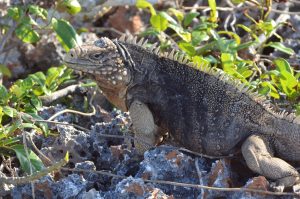The Erasmus Darwin Barlow Conservation programme aims to give conservationists of the future new skills and experiences, by funding two places each year to join a ZSL EDGE of Existence expedition. The expeditions are named in tribute to the late Dr Erasmus Barlow, a Founder Fellow and key contributor to the Society in his role as Secretary from 1980 to 1982.
The two early-career conservationists chosen this year were Joshua Blackman (a Zoology graduate from Queen Mary, University of London, and a budding bat enthusiast) and Katia Sanchez Ortiz (a 2nd year PhD student at the Natural History Museum, with a special interest in island ecosystems). In this first of two blog posts on the expedition, Joshua shares his experiences from the field working with one of the rarest bats in the world!
The 2017 Erasmus Darwin Barlow expedition took place between 26th January and 17th February and the chosen destination was Cuba! Cuba is not just the revolutionary, salsa-filled, rum-and-cigar-producing tropical island you may think of. Cuba is also ecologically fascinating and an important hotspot for many endemic EDGE species: Natalus primus (Cuban greater funnel-eared bat), Atopogale cubana (Cuban solenodon), Mesocapromys nanus (dwarf hutia), Mesocapromys sanfelipensis (SanFelipe hutia); important birds such as Chondrohierax wilsonii (Cuban kite) and Cyanolimnas cerverai (Zapata rail), and amphibians such as Eleutherodactylus spp. (robber frog spp.).
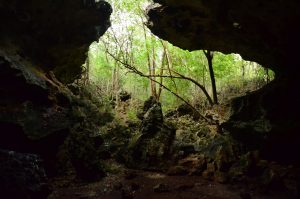
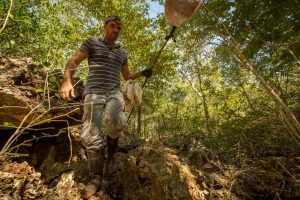
The first part of our Cuban expedition was focused on Natalus primus in Cueva La Barca (“the boat cave”). This cave – the only place that Natalus primus is known to roost in the entire world – is found on the wild Guanahacabibes peninsular of far western Cuba. Our team consisted of Dr. Oliver Wearn, Dr. Carolina Soto Navarro, Katia Sanchez Ortiz and I, and we were joined in Guanahacabibes by our local collaborator José Manuel de la Cruz Mora. José works for the Museum of Natural Sciences in Pinar Del Río and is an expert on the bats of Guanahacabibes.
Guanahacabibes is one of the most fascinating places I’ve ever visited. Once you pass the main gate into the protected park, you are surrounded by forest which has established itself on the remnants of ancient coral beds that over time have solidified into a rocky sharp terrain full of holes and sharp outcrops, known locally as “dog’s teeth”. Unfortunately I found out why it was awarded this nickname as my shoes were “bitten” countless times as I walked over it during fieldwork, leaving my shoes wedged in between the sharp angles and tearing holes in the soles and sides. On one occasion I had to remove my foot from my shoe and wrestle my shoe out of the strong grip of this unforgiving terrain. Traversing this was completely worth it as in our short time in Guanahacabibes we managed to see a great diversity of fascinating wildlife such as hutias, iguanas, bee hummingbirds, Cuban todys, Cuban trogons, peregrine falcons, Cuban black hawks, brown pelicans, turkey vultures, Cuban pygmy owls, crabs, boas, frogs, crocodiles and fifteen species of bats!
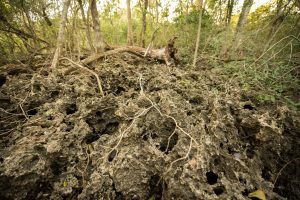
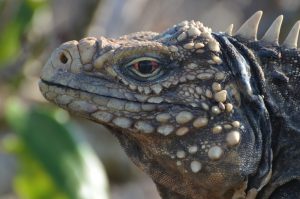
As if the forest and beaches weren’t fascinating enough, the main reason for us being there was for Cueva La Barca. It’s hard to put into words the absolute awe I felt when we first descended into that huge cave, guided only by our head torches. It felt like another world underground. A deafening mix of thousands of thudding wing-beats and high-pitched bat squeaks surrounded us whilst I felt hundreds of whooshes of air fly past my ears. Temperatures reached nearly 40° C in some sections and the guano floor was uneven, dusty and had the occasional crab, tarantula or boa lying in wait for a tasty bat meal.

Our aim was to record the different ultrasonic calls of Natalus primus and the other 12 co-habiting bats for a vocalisation library and to test a new low-cost audio recording technology, called the “AudioMoth”. AudioMoths are small devices capable of recording ultrasound as well as audible sounds. They resemble a small circuit board with a battery port, SD card port and an on-board microphone. Simple as that. The great thing about them is that, because they´re so much cheaper than the alternatives (which can cost more than £1000), it will allow for less well-funded countries and researchers to use this technology for the first time. We deployed the AudioMoths inside the cave and along transects outside of the cave on trees in the forest, with them set to record during feeding hours when the bats left the caves to forage. The devices worked well in the field and we were able to establish baseline monitoring and information on bat dispersal during foraging periods from the locations and times of their calls. During our time, José managed to catch every resident species and even multiple bats of some species. We took ultrasound recordings of the bats that José caught and we took photographs and videos of each species for the vocalisation library used by ourselves and our Cuban collaborators.
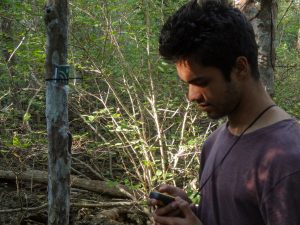
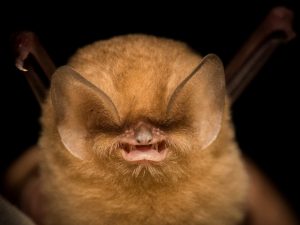
During our week visiting the cave, we also did some camera trap surveys to find out which holes Natalus primus was using to exit the cave and survey the surrounding forest for invasive species, such as feral pigs and black rats. We also used an infrared video camera to trial a roost counting method for Natalus primus, and to record the behaviour of thousands of bats in the “Guano swamp”. This swamp was as gross as it sounds! It was a huge deep pool of hot fluid guano which is impossible to cross, leaving us to wonder if there are even more inaccessible cave chambers beyond the swamp which may possibly be hiding even greater numbers of Natalus primus.
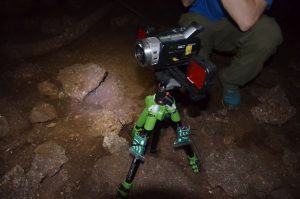
Carolina also spent many hours trialling 3D mapping of Cueva La Barca which will be used to recreate a three-dimensional map of the cave using “structure from motion”.

This exploratory expedition to Guanahacabibes gave us great insight into appropriate techniques for studying Natalus primus, we forged invaluable relationships with local collaborators such as José and hopefully it will lead to a wider conservation effort in future between researchers of these two countries to focus on protecting this vital ecosystem and Natalus primus.
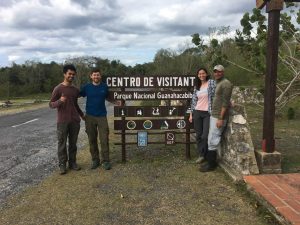
-Joshua Blackman
If you would like to stay updated on the ongoing work of the Zoological Society of London’s EDGE team then check out #EDGE2017 on Twitter and Instagram.
EDGE Twitter: https://twitter.com/edgeofexistence
EDGE Instagram: https://www.instagram.com/zsledgeofexistence/
